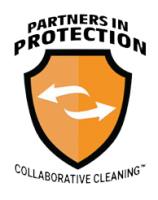INSPECTION & EVALUATION GUIDELINES
INSTRUCTIONS FOR EVALUATING THE CLEANING OF OBJECTS IN THE LONG-TERM CARE RESIDENT AREA
Long-Term Care facilities know the importance of standardizing the evaluation of cleaning, infection control, and environmental services activities. The guidance below provides an outline for adoption of a comprehensive evaluation and inspection program as highlighted in Step Three: Inspect For Protection of the Partners in Protection program. In essence, primary high-touch objects and surfaces need to be inspected on a consistent basis and it is important to evaluate the object or surface before and after servicing.
All available objects noted below should be marked for evaluation in each room.
Resident Area
- Bed rails: If the bed rail incorporates bed controls, evaluate the control area (on the patient/ resident side) slightly away from the control buttons. If the rails do not contain the new style control areas, the rails are best evaluated on the smooth inner surface in an area easily accessible to cleaning.
- Tray table: The top of the tray table should be evaluated in one corner.
- Call box: Evaluation is done on the back mid portion of the call box in an area easily accessible to cleaning. If tiny call buttons are used, mark the separate TV control box instead if feasible.
- Telephone: Evaluation is best done on the back side of the hand-held portion of the telephone near the top of the phone, away from the end that is attached to the phone wire.
- Bedside table: The drawer pull is evaluated.
- Patient chair: Evaluation is done in the center of the seat of the chair close to the rear of the cushion. If the cushion is covered in textured fabric, evaluate the arm of the chair.
- IV pole: For hanging IV poles, the shaft of the pole just above the textured grab area should be evaluated. For standing IV poles, the chest-high portion where hand contact is most common should be evaluated.
Resident Restroom
- Sinks: If using a targeting system, the best place to mark the sink rim is towards the rear in order to avoid water splash interference with evaluation of the target. If direct evaluation is used, the faucet handle should be evaluated.
- Bathroom and patient/resident room light switches: When using a targeting method, a target is placed on the plate portion of the light switch. When using a direct evaluation system, the switch or plate should be evaluated because of its relatively large surface area.
- Doorknobs and door levers: The inside door knob or lever is marked for each bathroom door and each patient room door.
- Toilet area hand holds (bathroom handrails): Evaluate the most accessible surface of the hand hold just off the edge of the textured surface at the curve where the hand hold goes towards the wall. If there are two hand holds, mark the one most likely to be touched by a patient using the toilet.
- Toilet seats: When using a targeting method, the target is placed on the back of the toilet seat just below the outside edge of the seat in an area readily accessible to cleaning activities.
- Toilet handles: When using a targeting method, the target is placed on top of the handle approximately two thirds away from the end of the handle.
- Bed pan cleaning equipment: Two types of bed pan cleaning equipment designed as part of toilet units are in general use in hospitals.
- Hinged pipe type cleaner: The most used bed pan cleaner consists of a pipe with a small shower head type device that is lowered over the toilet bowl by the user. When the arm is lowered, the toilet flush water is sprayed in a stream through the cleaner head. This device is best targeted by marking the spray head (the most common area which would be touched by users).
- Spray hoses: Some toilets have a spray hose with a lever-type trigger on the handle which is depressed to activate the spray head. Evaluate the handle itself.
Where Applicable:
- IV Pump control panel – Evaluate an area that is just adjacent to the portion of the panel that is most frequently touched by healthcare providers.
- Monitor control panel – When using a targeting method, the control panel should be evaluated in an area immediately adjacent to a part of the panel which is directly contacted by caregivers’ hands.
- Monitor touch screen – The touch screen should be evaluated in the lower right-hand corner in an area easily accessible to cleaning.
- Monitor cables – Evaluate the junction box area.
- Ventilator control panel – Evaluate an area immediately adjacent to a part of the panel which is most frequently touched by healthcare provider.





